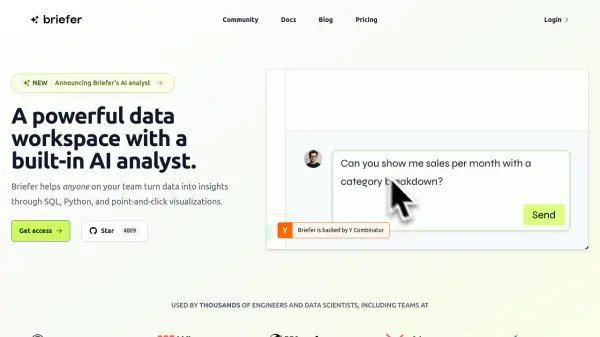What is Briefer?
Briefer provides a robust data workspace designed for collaboration, enhanced with a built-in AI analyst. It empowers team members, regardless of technical expertise, to convert raw data into actionable insights. Users can interact with their data through various methods including SQL queries, Python scripting, and intuitive point-and-click visualizations within a unified environment. The platform supports connections to numerous databases like BigQuery, PostgreSQL, Snowflake, and more, simplifying the data access process.
The tool facilitates seamless transitions between SQL and Python, automatically converting query results into Python dataframes for deeper analysis or visualization. Collaboration is central to Briefer, offering features like real-time multiplayer editing, commenting, and presentation modes to share findings effectively. Users can build interactive dashboards and even simple data applications, schedule automated report generation, and manage access with granular permissions, making it a comprehensive solution for modern data teams.
Features
- AI Analyst: Get answers and insights from data using an intelligent agent.
- SQL Support: Query databases (BigQuery, PostgreSQL, Snowflake, etc.) with AI assistance.
- Python Integration: Analyze and plot data using Python with AI-assisted coding and automatic dataframe conversion.
- Interactive Visualizations: Create charts and graphs using point-and-click or code.
- Notebooks & Dashboards: Build and share insights as interactive notebooks or dashboards.
- Real-time Collaboration: Edit documents simultaneously with multiplayer editing and comments.
- Scheduling & Notifications: Automate notebook runs and send PDF reports via email or Slack.
- Data Apps: Build interactive pages using inputs, dropdowns, and sliders for data exploration.
- Database Connectivity: Connect to various databases including BigQuery, PostgreSQL, Snowflake, Athena, Redshift, Trino, MySql, SQL Server, and CSV Imports.
Use Cases
- Generating data insights with AI assistance.
- Performing exploratory data analysis using SQL and Python.
- Building and sharing interactive data dashboards.
- Creating predictive models (e.g., churn prediction, demand forecasting).
- Automating data reporting and monitoring.
- Collaborating on data projects within a team.
- Developing simple data applications for internal use (e.g., model prototyping, customer segmentation).
Related Queries
Helpful for people in the following professions
Briefer Uptime Monitor
Average Uptime
99.86%
Average Response Time
86.1 ms
Featured Tools
Join Our Newsletter
Stay updated with the latest AI tools, news, and offers by subscribing to our weekly newsletter.











